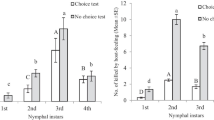Abstract
Strawberry guava, Psidium cattleianum Sabine, is a woody tree or shrub native to coastal southeastern Brazil. Strawberry guava was introduced into Florida in the late 1800s as an ornamental species. The plant escaped cultivation and is invading natural areas throughout the southern half of the state. In addition to negative effects on Florida’s native ecosystems, strawberry guava also is a preferred host of the Caribbean fruit fly, Anastrepha suspensa Loew (Diptera: Tephritidae).
In total, 57 plant species representing 21 families were included in the host range tests. First instar nymphs of Tectococcus ovatus Hempel fed on two closely related guava species, Brazilian guava (Psidium friedrichsthalianum O. Berg), and Costa Rican guava (Psidium guineense Sw.). However, none of the nymphs completed their development on these two non-target species. The results of the host specificity tests suggest that T. ovatus is a suitable candidate for classical biological control of strawberry guava in Florida.
Similar content being viewed by others
References
Da Costa Lima, A., 1936. Terceiro Catalogo dos Insectos que Vivem nas Plantas do Brasil. Directoria da Estatistica da Produccao, Seccao de Publicidade, Rio de Janeiro, 460 pp.
FDACS (Florida Department of Agricultural and Consumer Services), December 2004. Minutes of the noxious weeds and invasive plant review committee meeting. Division of Plant Industry. url. http://www.doacs.state.fl.us/pi/enpp/botany/noxweed.html
FDACS, June 2005. Caribbean fruit fly-free protocol. url. http://www.doacs.state.fl.us/onestop/plt/cfffprotocol.html
Ferriter, A., 2003. Explore your alter-natives: a plant substitution guide for south Florida. Wildland Weeds 6(4), insert
FLEPPC (Florida Exotic Pest Plant Council), November 2003. List of invasive species. url. http://www.fleppc.org/Plantlist/03list.htm
Greany P.D., CRiherd C. (1993). Caribbean fruit fly status, economic importance, and control (Diptera: Tephritidae). Florida Entomologist 76:209–211
Harris P., Shorthouse J.D. (1996). Effectiveness of gall inducers in weed biological control. The Canadian Entomologist 128:1021–1055
Heard, T., 1997. Host range testing of insects. In: M. Julien and G. White (eds), Biological Control of Weeds: Theory and Practical Application. ACIAR Monograph Series, Canberra, Australia, 192 pp.
Hoy J.M. (1963). A catalogue of the Eriococcidae (Homoptera: Coccoidea) of the world. New Zealand Department of Scientific and Industrial Research Bulletin 150:1–260
Huenneke L.F., Vitousek P.M. (1990). Seedling and clonal recruitment of the invasive tree Psidium cattleianum: implications for management of native Hawaiian forests. Biological Conservation 53:199–211
IFAS (University of Florida, Institute of Food and Agricultural Sciences), 2005. Conclusion from the IFAS assessment of the status of non-native plants in Florida’s natural areas. Florida Cooperative Extension Service, Institute of Food and Agricultural Sciences, University of Florida. 5 pp.
Langeland K., Hall D. (2000). Exotic guavas in Florida: so delicious but-. Wildland Weeds 3:4–11
Morton, J.F., 1987. Fruits of Warm Climates. Morton, J.F., Miami, Florida, 505 pp.
Nguyen R.U., Poucher C., Brazzel J.R. (1992). Seasonal occurrence of Anastrepha suspensa (Diptera: Tephritidae) in Indian River County, Florida, 1984–1997. Journal of Economic Entomology 85:813–820
Schroeder C.A., Coit J.E. (1944). The cattley (commonly known as strawberry guava). California Avocado Society Yearbook 29:44–47
Smith, C.W., 1985. Impact of alien plants on Hawaii’s native biota. In: C.P. Stone, J.M. Scott (eds), Hawai’i’s Terrestrial Ecosystems Preservation and Management Cooperative National Park Resources Studies Unit, Honolulu. pp. 180–250.
Tunison, T., 1991. Element stewardship abstract for Psidium cattleianum. The Nature Conservancy. url. http://www.theweeds.ucdavis.edu/esadocs/documents/psidcat.pdf
United States Department of Agriculture (USDA), Animal and Plant Health Inspection Service (APHIS), Plant Protection and Quarantine (PPQ), 2000. Reviewer’s Manual for the Technical Advisory Group for Biological Control Agents of Weeds: Guidelines for Evaluating the Safety of Candidate Biological Control Agents. 224 pp.
Vitorino, M.D., J.H. Pedrosa-Macedo and C.W. Smith, 2000. The Biology of Tectococcus ovatus Hempel (Heteroptera: Eriococcidae) and its Potential as a Biocontrol Agent of Psidium cattleianum (Myrtaceae). Proceedings of the X International Symposium on Biological Control of Weeds, 4–14 July, Bozeman, Montana. pp. 651–657.
Wagner, W.L., D.R. Herbst and S.H. Shomer, 1999. Manual of the Flowering Plants of Hawaii. Bishop Museum and University of Hawaii Press, Honolulu, 1919 pp.
Wapshere A.J. (1974). A strategy for evaluating the safety of organisms for biological weed control. Annnals of Applied Biology 77:201–211
Wikler C. (2000). Psidium cattleianum, deliciously dangerous in Hawaii. Wildland Weeds 3:5–10
Wikler, C., J.H. Pedrosa-Macedo, M.D. Vitorino, M.G. Caxambú and C.W. Smith, 2000. Strawberry guava (Psidium cattleianum) - prospects for biological control. Proceedings of the X International Symposium on Biological Control of Weeds, 4–14 July, Bozeman, Montana, pp. 659–665
Acknowledgments
The authors would like to thank the botanists Mark A. Garland and Richard Weaver for their professional assistance with nomenclature, identification, and collection of many specimens used throughout this project. Thanks are also due to Judy Gillmore for her assistance in procuring and maintaining test plants. This research was funded by the USDA CSREES Tropical/Subtropical Agriculture Research program (T-STAR-Caribbean) grant No. 01062227.
Author information
Authors and Affiliations
Corresponding author
Rights and permissions
About this article
Cite this article
Wessels, F.J., Cuda, J.P., Johnson, M.T. et al. Host specificity of Tectococcus ovatus (Hemiptera: Eriococcidae), a potential biological control agent of the invasive strawberry guava, Psidium cattleianum (Myrtales: Myrtaceae), in Florida. BioControl 52, 439–449 (2007). https://doi.org/10.1007/s10526-006-9043-3
Received:
Accepted:
Published:
Issue Date:
DOI: https://doi.org/10.1007/s10526-006-9043-3




